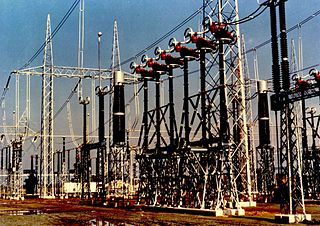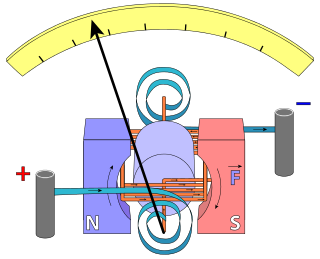Related Research Articles

An electrical insulator is a material in which electric current does not flow freely. The atoms of the insulator have tightly bound electrons which cannot readily move. Other materials—semiconductors and conductors—conduct electric current more easily. The property that distinguishes an insulator is its resistivity; insulators have higher resistivity than semiconductors or conductors. The most common examples are non-metals.

A transformer is a passive component that transfers electrical energy from one electrical circuit to another circuit, or multiple circuits. A varying current in any coil of the transformer produces a varying magnetic flux in the transformer's core, which induces a varying electromotive force (EMF) across any other coils wound around the same core. Electrical energy can be transferred between separate coils without a metallic (conductive) connection between the two circuits. Faraday's law of induction, discovered in 1831, describes the induced voltage effect in any coil due to a changing magnetic flux encircled by the coil.
In electrical engineering, partial discharge (PD) is a localized dielectric breakdown (DB) of a small portion of a solid or fluid electrical insulation (EI) system under high voltage (HV) stress. While a corona discharge (CD) is usually revealed by a relatively steady glow or brush discharge (BD) in air, partial discharges within solid insulation system are not visible.

An isolation transformer is a transformer used to transfer electrical power from a source of alternating current (AC) power to some equipment or device while isolating the powered device from the power source, usually for safety reasons or to reduce transients and harmonics. Isolation transformers provide galvanic isolation; no conductive path is present between source and load. This isolation is used to protect against electric shock, to suppress electrical noise in sensitive devices, or to transfer power between two circuits which must not be connected. A transformer sold for isolation is often built with special insulation between primary and secondary, and is specified to withstand a high voltage between windings.

An electric arc is an electrical breakdown of a gas that produces a prolonged electrical discharge. The current through a normally nonconductive medium such as air produces a plasma, which may produce visible light. An arc discharge is initiated either by thermionic emission or by field emission. After initiation, the arc relies on thermionic emission of electrons from the electrodes supporting the arc. An arc discharge is characterized by a lower voltage than a glow discharge. An archaic term is voltaic arc, as used in the phrase "voltaic arc lamp".

A current transformer (CT) is a type of transformer that is used to reduce or multiply an alternating current (AC). It produces a current in its secondary which is proportional to the current in its primary.

In an electric power system, a switchgear is composed of electrical disconnect switches, fuses or circuit breakers used to control, protect and isolate electrical equipment. Switchgear is used both to de-energize equipment to allow work to be done and to clear faults downstream. This type of equipment is directly linked to the reliability of the electricity supply.
Transformer oil or insulating oil is an oil that is stable at high temperatures and has excellent electrical insulating properties. It is used in oil-filled wet transformers, some types of high-voltage capacitors, fluorescent lamp ballasts, and some types of high-voltage switches and circuit breakers. Its functions are to insulate, suppress corona discharge and arcing, and to serve as a coolant.
Condition monitoring is the process of monitoring a parameter of condition in machinery, in order to identify a significant change which is indicative of a developing fault. It is a major component of predictive maintenance. The use of condition monitoring allows maintenance to be scheduled, or other actions to be taken to prevent consequential damages and avoid its consequences. Condition monitoring has a unique benefit in that conditions that would shorten normal lifespan can be addressed before they develop into a major failure. Condition monitoring techniques are normally used on rotating equipment, auxiliary systems and other machinery like belt-driven equipment,, while periodic inspection using non-destructive testing (NDT) techniques and fit for service (FFS) evaluation are used for static plant equipment such as steam boilers, piping and heat exchangers.

Predictive maintenance techniques are designed to help determine the condition of in-service equipment in order to estimate when maintenance should be performed. This approach promises cost savings over routine or time-based preventive maintenance, because tasks are performed only when warranted. Thus, it is regarded as condition-based maintenance carried out as suggested by estimations of the degradation state of an item.

In electric power, a bushing is a hollow electrical insulator that allows an electrical conductor to pass safely through a conducting barrier such as the case of a transformer or circuit breaker without making electrical contact with it. Bushings are typically made from porcelain, though other insulating materials are also used.

In electrical engineering, treeing is an electrical pre-breakdown phenomenon in solid insulation. It is a damaging process due to partial discharges and progresses through the stressed dielectric insulation, in a path resembling the branches of a tree. Treeing of solid high-voltage cable insulation is a common breakdown mechanism and source of electrical faults in underground power cables.
In Electrical Power Systems and Industrial Automation, ANSI Device Numbers can be used to identify equipment and devices in a system such as relays, circuit breakers, or instruments. The device numbers are enumerated in ANSI/IEEE Standard C37.2 "Standard for Electrical Power System Device Function Numbers, Acronyms, and Contact Designations".
Dissolved gas analysis (DGA) is an examination of electrical transformer oil contaminants. Insulating materials within electrical equipment liberate gases as they slowly break down over time. The composition and distribution of these dissolved gases are indicators of the effects of deterioration, such as pyrolysis or partial discharge, and the rate of gas generation indicates the severity. DGA is beneficial to a preventive maintenance program.
VLF cable testing is a technique for testing of medium and high voltage cables. VLF systems are advantageous in that they can be manufactured to be small and lightweight; making them useful – especially for field testing where transport and space can be issues. Because the inherent capacitance of a power cable needs to be charged when energised, system frequency voltage sources are much larger, heavier and more expensive than their lower-frequency alternatives. Traditionally DC hipot testing was used for field testing of cables, but DC testing has been shown to be ineffective for withstand testing of modern cables with polymer based insulation. DC testing has also been shown to reduce the remaining life of cables with aged polymer insulation.
The electrical insulation system for wires used in generators, electric motors, transformers, and other wire-wound electrical components is divided into different classes by temperature and temperature rise. The electrical insulation system is sometimes referred to as insulation class or thermal classification. The different classes are defined by NEMA, Underwriters Laboratories (UL), and IEC standards.
Sweep frequency response analysis (SFRA) is a method to evaluate the mechanical integrity of core, windings and clamping structures within power transformers by measuring their electrical transfer functions over a wide frequency range.
A severity factor is established as a coefficient to assess the dielectric severity supported by a transformer winding considering the incoming transient overvoltage. It determines the safety margin regarding to the standard acceptance tests either in the frequency or time domain.

In electrical engineering, current sensing is any one of several techniques used to measure electric current. The measurement of current ranges from picoamps to tens of thousands of amperes. The selection of a current sensing method depends on requirements such as magnitude, accuracy, bandwidth, robustness, cost, isolation or size. The current value may be directly displayed by an instrument, or converted to digital form for use by a monitoring or control system.
References
- ↑ Arvind Dhingra, Singh Khushdeep and Kumar Deepak, "Condition monitoring of power transformer: A review." Transmission and Distribution Conference and Exposition, 2008. T&D. IEEE/PES. IEEE, 2008.
- ↑ W. H. Tang and Q. H. Wu, “Condition Monitoring and Assessment of Power Transformers Using Computational Intelligence”, Springer, 2011
- ↑ Tang, W. H., Q. H. Wu, and Z. J. Richardson. "Equivalent heat circuit based power transformer thermal model." Electric Power Applications, IEE Proceedings-. Vol. 149. No. 2. IET, 2002. ISSN 1350-2352.
- ↑ Emsley, A. M., and G. C. Stevens. "Review of chemical indicators of degradation of cellulosic electrical paper insulation in oil-filled transformers." Science, Measurement and Technology, IEE Proceedings-. Vol. 141. No. 5. IET, 1994.
- ↑ Wang, Dian. Ontology-based fault diagnosis for power transformers. Diss. University of Liverpool, 2011.
- ↑ Abu-Elanien, Ahmed EB, and M. M. A. Salama. "Survey on the transformer condition monitoring." Power Engineering, 2007 Large Engineering Systems Conference on. IEEE, 2007.
- ↑ Gonzalez, Carlos, et al. "Transformer diagnosis approach using frequency response analysis method." IEEE Industrial Electronics, IECON 2006-32nd Annual Conference on. IEEE, 2006.
- ↑ Bartnikas, R. "Partial discharges. Their mechanism, detection, and measurement." Dielectrics and Electrical Insulation, IEEE Transactions on 9.5 (2002): 763-808.
- ↑ Stone, G. C., et al. "Practical implementation of ultrawideband partial discharge detectors." Electrical Insulation, IEEE Transactions on 27.1 (1992): 70-81.
- Giesecke, J.L. Transformer Condition Assessment using HFCT method. see article in transformers-magazine.com July 2016
